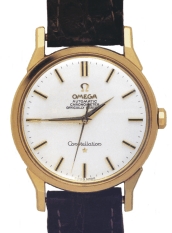![]()
A chronometer is an extremely accurate watch or clock. The movement has been tested for accuracy in 5 different positions and at various temperatures which simulate Arctic and Tropical conditions under which the watch will be worn. Most chronometers are mechanical watches because there is little need to prove a quartz watches accuracy, as electronic quartz technology is by definition an ultra-precise form of time keeping. The tests are conducted by the Swiss Official Chronometer Control (Controle Officiel Suisse des Chronometres, or COSC). COSC is an independent association governed by Swiss Avil Code. The tests are very involved and elaborate, cameras and computers are used to analyse the data.
|
Test 1
|
Mean Daily Rate The timekeeping must be between -4 to +6 seconds a day for 10 days. |
|
Test 2
|
Mean Variation Rates Timed over 10 days in 5 different positions the mean variation in rates can be no more than 2 seconds. |
|
Test 3
|
Greatest Variation Cannot vary more than 5 seconds a day in any position. |
|
Test 4
|
Horizontal and Vertical Difference The average timekeeping over 2 days in the vertical position is subtracted from the average timekeeping in the horizontal position. The difference must be no more than -6 to +8 seconds. |
|
Test 5
|
The Greatest Deviation in Rates The difference between the greatest daily rate and the mean daily rate can be no more than 10 seconds a day. |
|
Test 6
|
Temperature Variation Rate The variation between timekeeping at 8 degrees Celsius and at 38 degrees Celsius must be no more than 0.6 seconds a day. |
|
Test 7
|
Resumption of the Rate The resumption must be no more than 5 seconds, when the average mean daily rate of the first two days is subtracted from the mean daily rate of the last day. |
 |
 |
 |
 |
|
|
INVICTA, 1960's
|
JAEGER-LECOULTRE, c 1950
|
|||
![]()
 |
Watches I have repaired, restored and overhauled have obtained chronometer certificates with mention of "very good rate results". Servicing a chronometer is different from overhauling a normal timepiece. More time is spent in adjusting the timekeeping than the stripping and re-assembly. All the timepieces marked chronometer have the potential of becoming excellent timekeepers.
|
||||||
- The Omega Constellation Chronometer -The 1st constellation model was introduced in 1952. The automatic movement
calibre 354-28-10, seventeen jewels, self winding mechanism with rotor
winding in one direction with bumper springs. These watches are now known
as Bumpers. All constellations have the observatory under the night sky
emblem on the case back. |
|
|
 |
|